Auditoría de redes sociales: ¿cómo realizarla en 9 sencillos pasos?
Índice
Una auditoría de redes sociales requiere tiempo, concentración y, sobre todo, experiencia. Pero la verdad es que realizar una auditoría de redes sociales puede transformar por completo tu estrategia en redes sociales y tu rendimiento online si sabes dónde buscar. Además, con herramientas avanzadas, es una tarea bastante fácil.
Entonces, ¿cómo se realiza una auditoría de redes sociales? ¡Vamos a descubrirlo!
Resumen rápido:
- Una auditoría de las redes sociales ayuda a clarificar el rendimiento de sus contenidosEs un paso clave para entender lo que funciona y lo que hay que mejorar. Es un paso clave para entender qué funciona y qué hay que mejorar.
- Puede detectar tendencias, identificar áreas de bajo rendimiento y optimizar sus esfuerzos en consecuencia. Revisando periódicamente parámetros clave como el alcance, la participación, el sentimiento y el crecimiento de la audiencia,
- El uso de herramientas de auditoría de redes sociales como Brand24 agilizará este proceso. Estas herramientas combinan datos de distintas plataformas en un solo lugar. Simplifican la elaboración de informes y ofrecen recomendaciones inteligentes basadas en sus datos internos.
En este artículo, lo desglosaré todo para cada pregunta:
- ¿Cómo se lleva a cabo una auditoría eficaz de las redes sociales?
- ¿Qué herramientas debe utilizar?
- ¿Con qué frecuencia se debe realizar?
- ¿Existe algún ejemplo o plantilla fiable de auditoría de redes sociales?
Paso a paso, para que pueda realizar su auditoría utilizando esta plantilla de auditoría de redes sociales con confianza y claridad.
¿Qué es una auditoría de redes sociales?
Una auditoría de redes sociales debe incluir toda la información analizada sobre tu cuenta en todas las plataformas sociales. Esto puede abarcar desde el rendimiento de tus publicaciones hasta tu estrategia y objetivos en redes sociales.
Y aunque la palabra auditoría Puede que suene un poco intimidante, pero no te preocupes, ¡es más fácil de lo que crees!
Considérelo como una parte integral del trabajo en las redes sociales. El objetivo es garantizar que todo funcione como debería y que se obtengan los resultados deseados.
| Auditoría de redes sociales: definición | Una revisión estructurada de tu presencia en todas las plataformas sociales para comprender qué funciona, qué no funciona y cómo tu estrategia se alinea con tus objetivos. Incluye tu rendimiento, el comportamiento de tu audiencia y tu estrategia general en las redes sociales. |
| Por qué es importante? | Una auditoría de redes sociales te ayuda a mantenerte en el buen camino, identificar áreas de mejora y confirmar que tu contenido y tus actividades están dando los resultados que deseas. |
¿Por qué es importante una auditoría de las redes sociales?
Una auditoría de redes sociales es importante porque te ayuda a comprender qué funciona y qué no.
Te proporciona información clara que te ayuda a tomar mejores decisiones y mejorar tu rendimiento social en general.
Pero también aporta beneficios muy específicos que debes tener en cuenta:
| Beneficio | Descripción |
|---|---|
| Descubre qué contenido funciona realmente. | Comprende qué publicaciones, formatos y temas generan los mejores resultados. |
| Descubra nuevas oportunidades de crecimiento y compromiso. | Identifica audiencias, canales o ideas de contenido sin explotar. |
| Descubra información detallada sobre su público | Obtenga más información sobre quién interactúa con su contenido y por qué. |
| Alinear el contenido con los objetivos empresariales. | Asegúrate de que la actividad social apoye los objetivos generales de la empresa. |
| Optimizar las áreas con bajo rendimiento | Detecta los puntos débiles y ajusta la estrategia para mejorar la eficiencia. |
| Mantén una imagen de marca clara y coherente. | Verifica que el tono, las imágenes y los mensajes sean coherentes en todas las plataformas. |
¿Cómo realizar una auditoría de redes sociales?
Cuando realizo una auditoría de redes sociales, me gusta seguir la regla: de lo general a lo específico.
- Comience con la preparación, los objetivos generales del negocio y una primera impresión de la marca en las plataformas de redes sociales.
- Analiza las métricas clave de las redes sociales, revisa el rendimiento de cada página de redes sociales e incluso examina las publicaciones individuales para comprender qué contenido realmente resuena en la audiencia.
- Por último, paso a análisis de la competencia para ver cómo nos comparamos en el sector y detectar nuevas oportunidades de crecimiento.
¡Y listo! Ya tienes cubiertos los aspectos básicos de una auditoría de redes sociales.
¿Cómo realizar una auditoría de redes sociales? [Paso a paso]
Es fácil realizar una auditoría de este tipo si tienes claro cómo hacerlo... (¡No me digas, Sherlock! :P)
Por eso he incluido un tutorial paso a paso que puedes seguir:
Básicamente, necesitas revisar sistemáticamente todos tus perfiles sociales, métricas de rendimiento, datos de audiencia y eficacia del contenido.
Siga estos pasos:
01 Definir los objetivos de la estrategia de marketing
Establecer objetivos claros es el primer paso y el más importante para el éxito de cualquier estrategia en las redes sociales.
No empezaría a entrenar en el gimnasio sin saber qué quiero mejorar (ya sea fuerza, resistencia o flexibilidad), y no me lanzaría a una auditoría de redes sociales sin tener claro mi objetivo.
Al fin y al cabo, sin objetivos es demasiado fácil perder la motivación, actuar sin propósito o incluso sabotear los propios resultados.
💡El truco está en ser ambas cosas. específico y realista.
Una vez que tengas una comprensión sólida de lo que quieres lograr, no solo en general, sino para cada plataforma individual, puedes elaborar un plan que te ayude a conseguirlo.
¿Qué son los objetivos de las redes sociales?
Tus objetivos en las redes sociales pueden incluir:
- Aumentar la notoriedad de la marca
- Descubrir los puntos fuertes de la audiencia
- Generar ventas
- Fomentar la participación del público
- Aumentar el tráfico de su sitio web
- Amplio alcance en las redes sociales
O algo más, ¡dímelo tú!
02 Crear una hoja de cálculo de canales sociales
Anotar todos los datos necesarios es esencial para el éxito de una auditoría de redes sociales.
Debe recopilar datos relevantes de cada una de sus cuentas en las redes sociales. Aunque al principio te lleve mucho tiempo. Pero créeme, tenerlo todo en un mismo sitio marca una gran diferencia.
Cuando centralizo todos los datos de auditoría de mis redes sociales en un solo archivo, resulta mucho más fácil comparar los resultados a lo largo del tiempo: mes a mes, trimestre a trimestre o año a año.
Esto me permite obtener una visión general clara y basada en datos del rendimiento en todos los canales.
¿Cómo recopilar datos de las redes sociales?
Dado que cada plataforma tiene métricas diferentes, cree una fila separada para cada canal a fin de realizar un seguimiento más eficaz del rendimiento.
También voy a añadir una columna especial para anotar cualquier observación o idea durante el proceso de auditoría.
03 Cree una lista de todas sus cuentas sociales
Una vez fijados los objetivos y la hoja de cálculo, es hora de empezar a rellenar los datos.
Siempre empiezo por hacer una lista de todas las cuentas de redes sociales de la marca.
¿Debo incluir los perfiles inactivos?
Sí, incluso los que ya no están activos o solo se utilizan ocasionalmente.
Es normal no estar activo en todas las plataformas, pero es importante recordar que estas cuentas siguen existiendo.
¿Quién sabe? Podrían servir como valioso punto de contacto con un nuevo público objetivo o confundir a sus seguidores. Una auditoría de redes sociales es el momento perfecto para comprobarlo.
Consejo profesional: puedes simplificarlo utilizando herramientas que recopilan tus datos sociales en un solo lugar. De esta manera, no tendrás que hacerlo todo manualmente y podrás pasar directamente al análisis (ve al número 5)..
04 Asegúrese de que su marca es coherente
Al crear la lista de todas sus plataformas de medios sociales, fíjese bien en que su marca sea coherente.
La marca es esencial.
Te diferencia de la competencia y comunica quién eres a tu público.
Asegúrate de que tus seguidores puedan reconocer inmediatamente el perfil de tu empresa, independientemente de dónde lo vean.
¿Cómo garantizar la coherencia de la marca?
- Comprueba las fotos de perfil y de portada.: Asegúrese de que coinciden con su marca actual y cumplen los requisitos de tamaño de imagen de cada plataforma.
- Utiliza nombres de usuario coherentes.: Utilice el mismo nombre de usuario en todos los perfiles de las redes sociales para facilitar su reconocimiento.
- Actualizar URL: Comprueba dos veces el enlace de tu biografía. Es fácil olvidar enlaces de campañas pasadas que ya no son relevantes.
- Escribe una biografía clara.: Elabore una biografía fácil de usar que describa con precisión su marca y lo que ofrece.
- Verifica tu perfil: Utiliza plataformas que ofrezcan verificación. Un perfil verificado aumenta la confianza en la marca y ayuda a tu público a saber que están en el lugar correcto.
05 Identificar los indicadores clave de rendimiento
Una de las tareas más difíciles en una auditoría de redes sociales es identificar las métricas correctas para realizar un seguimiento.
Con tantas opciones disponibles, ¿cómo saber cuáles son las más importantes para su empresa?
¿Qué incluir en una auditoría de redes sociales?
Aquí tienes una lista de métricas clave para la auditoría de redes sociales, que yo siempre compruebo en primer lugar:
- Métricas de participación en las redes sociales
- Acciones
- Número de menciones
- Impresiones
- Tráfico de referencia
- Clics en enlaces
- Alcance en las redes sociales
¿Cómo obtener datos de las redes sociales?
Así que hay dos opciones.
En primer lugar, puedes gestionar manualmente cada una de tus cuentas sociales en aplicaciones nativas (pero te llevará mucho tiempo y, sinceramente, es difícil tener una visión completa del rendimiento de tus redes sociales).
Por eso he preferido el segundo enfoque.
Herramientas avanzadas como herramientas de escucha social Recopilar datos de todos mis perfiles en redes sociales e incluso de aquellos canales en los que no tengo cuentas, pero en los que la gente habla de mí.
Esto lo convierte en la mejor opción para el reconocimiento de marca, la medición de la presencia en redes sociales y el análisis de la competencia.
Eche un vistazo.
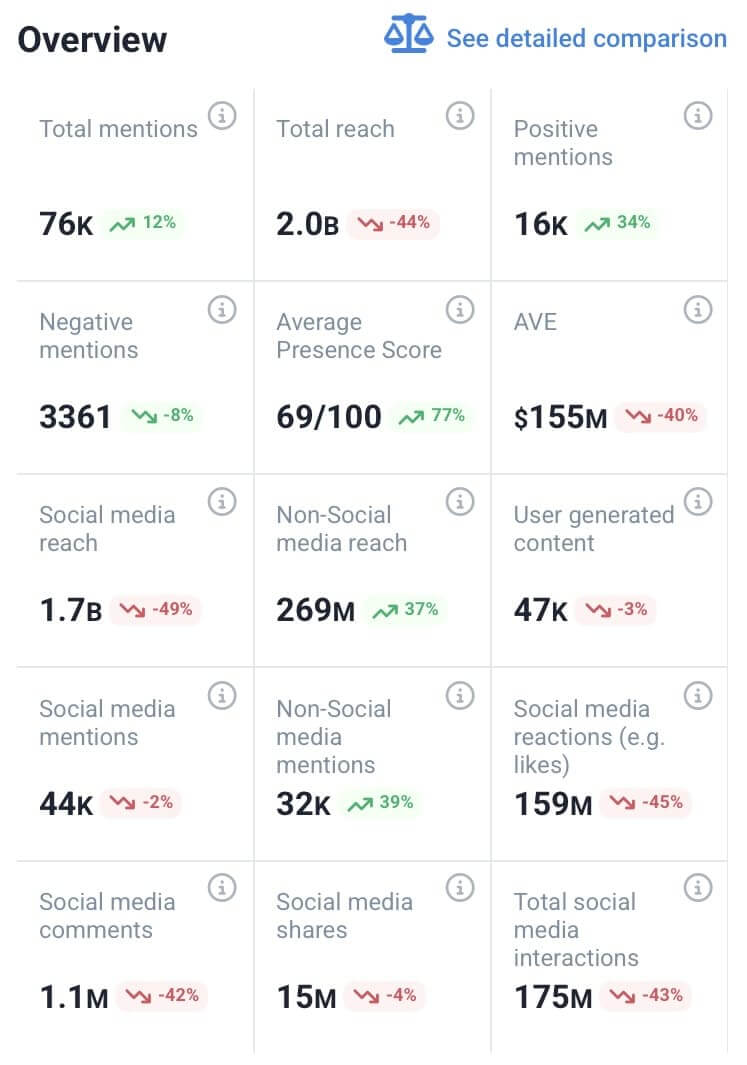
Como puede ver, la herramienta proporciona un resumen completo de las métricas clave de rendimiento de su presencia en línea en un solo panel de control.
Puedes filtrar fácilmente por canal para ver el rendimiento de una cuenta específica
Aquí puede leer más sobre métricas de las redes sociales para comprobarlos mientras realiza su auditoría de redes sociales.
06 Identificar los contenidos que importan
Las métricas son cruciales en una auditoría de redes sociales. Pero recuerde que detrás de cada número hay un persona real.
¿El verdadero objetivo? Entender qué le importa a su público, qué busca y cómo su marca puede satisfacer esas necesidades.
Ahora bien, comparar las publicaciones de distintas plataformas no siempre es fácil. Incluso con una hoja de cálculo, sacar conclusiones significativas puede llevar tiempo y esfuerzo.
Ahí es donde recurro a un herramienta de seguimiento de redes sociales. Me ayuda a descubrir ideas clave como:
- Los autores más populares
- Las menciones más populares
- Alcance estimado en las redes sociales
- Interacción en las redes sociales
- Me gusta en las redes sociales
- Comentarios en las redes sociales
- El volumen de menciones
Y muchos más.
¿Cómo encontrar datos para una auditoría de redes sociales?
Tengo tres formas favoritas de supervisar la presencia actual de mi marca en las redes sociales:
- Pista mentions
Siempre estoy atento al gráfico principal por si se producen picos repentinos en mentions o un bullicio inusual.
Muestran al instante qué ha provocado el pico y cómo interactúa la gente con la marca.
Además, también incluye los mention en los que no estás etiquetado.

Utiliza un dispositivo inteligente. rastreador de redes sociales para descubrir mentions, menciones de influencers y tendencias de audiencia. ¡Sin necesidad de búsquedas manuales!
- Encuentra los mejores mention (en la pestaña Resumen)
La pestaña Resumen me ayuda a identificar los mention más populares y los perfiles públicos más destacados sobre mi marca.
Aquí es donde puedo captar rápidamente los mensajes llamativos de personas influyentes, revistas o actores clave del sector.
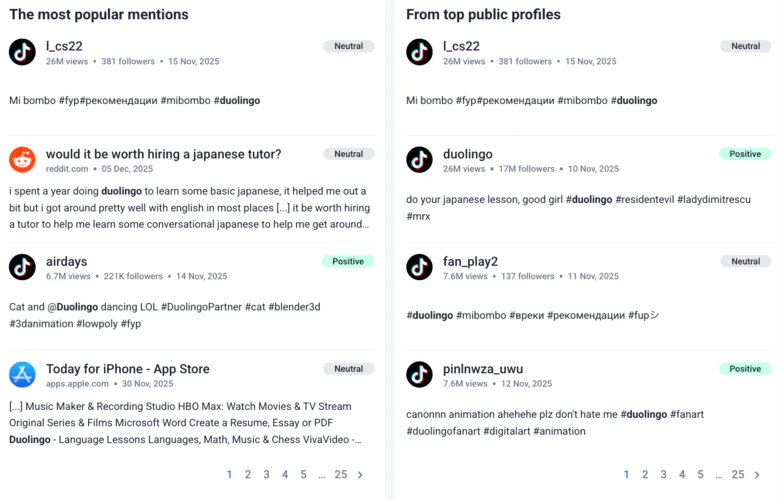
- Comprender las tendencias de la audiencia
Una vez que he revisado los mention inmediatos, me gusta ir a la pestaña Análisis de temas. Esta es, sin duda, mi función favorita.
En cuestión de segundos, puedo ver lo que mi público comenta en las plataformas sociales, lo que añade mucho contexto a mis auditorías.
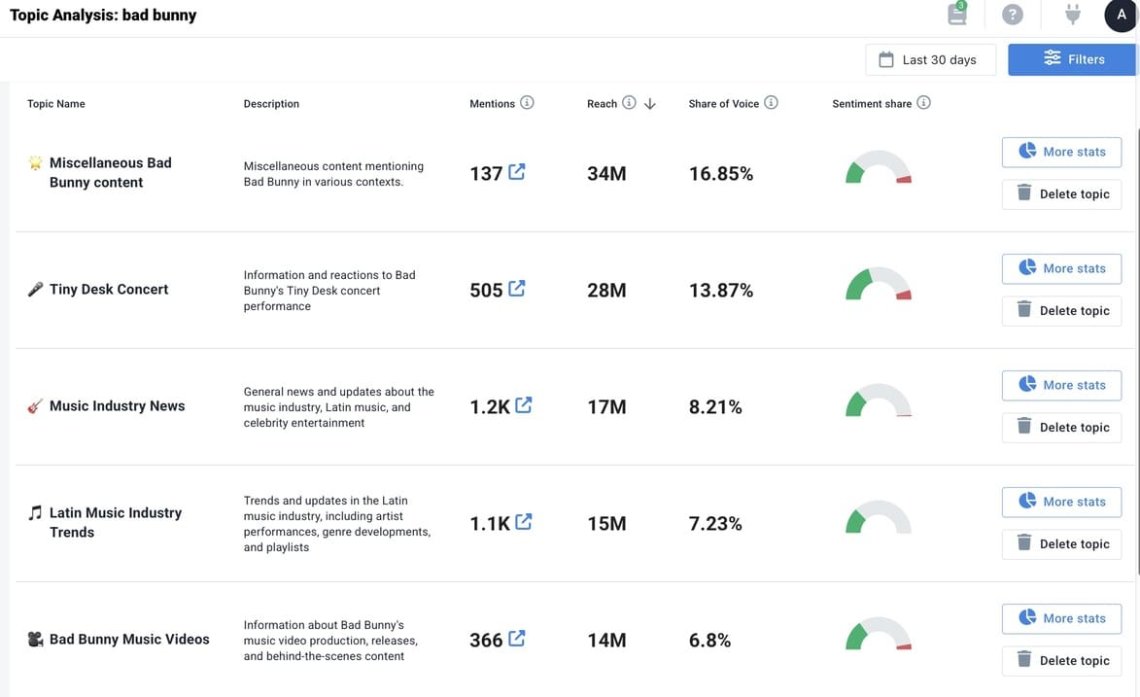
¿Puede la IA realizar una auditoría de redes sociales?
Sí, hasta cierto punto. Es posible que los LLM no tengan acceso a las estadísticas más recientes, pero las herramientas avanzadas son excelentes para este tipo de tareas.
Por ejemplo, Análisis temático de la IA es una mina de oro para comprender el comportamiento de la audiencia y las tendencias de participación.
Puede ayudarte a descubrir nuevas ideas para futuras campañas en redes sociales, alinear el calendario de contenidos y sentar las bases para futuras actividades en redes sociales.
07 Análisis de opiniones
Una de las partes más importantes, y a veces más olvidadas, de una auditoría de redes sociales es Comprender lo que siente su público por su marca, sus productos y su servicio de atención al cliente.
Uno de los principales objetivos de cualquier esfuerzo en las redes sociales es construir y mantener relaciones genuinas.
Ahí es donde entra en juego el análisis de sentimiento. Le ayuda a determinar si los mention de la marca están escritos en un tono positivo, negativo o neutro.
¿Qué hay que supervisar para el análisis del sentimiento en las redes sociales?
- Número de mention por tipo de sentimiento a través de diversas plataformas de medios sociales
- Cambios en el tono positivo/negativo a lo largo del tiempo
- Los desencadenantes de los rumores: ¿Qué ha provocado los picos de confianza?
Aquí puede ver los mention detectados por Brand24, y clasificados por sentimiento:
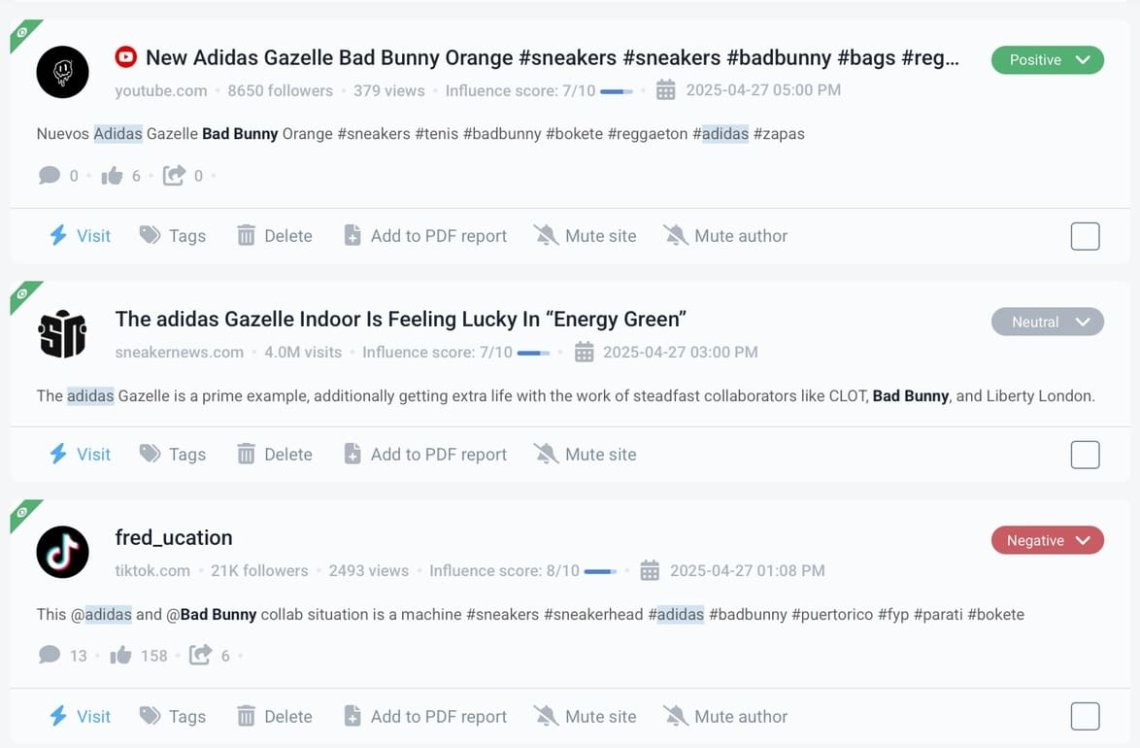
¿Cómo realizar un análisis del sentimiento en las redes sociales?
En el panel Brand24, cambio el gráfico de Mentions & Reach a Sentiment. Esto me da un desglose visual de cómo se siente la gente cuando habla de mi marca.
Es útil, especialmente después de lanzar una nueva campaña, producto o asociación.
Es la forma más rápida de saber qué funciona y qué no para el público objetivo.

Voy más allá y desgloso el sentimiento en cada plataforma de medios sociales. Para captar las diferencias en la presencia en los medios sociales, algunas plataformas obtienen naturalmente mejores resultados que otras.
Saber esto me ayuda a asignar sabiamente el presupuesto y el esfuerzo en mi estrategia de contenidos y en mis próximas campañas en las redes sociales.
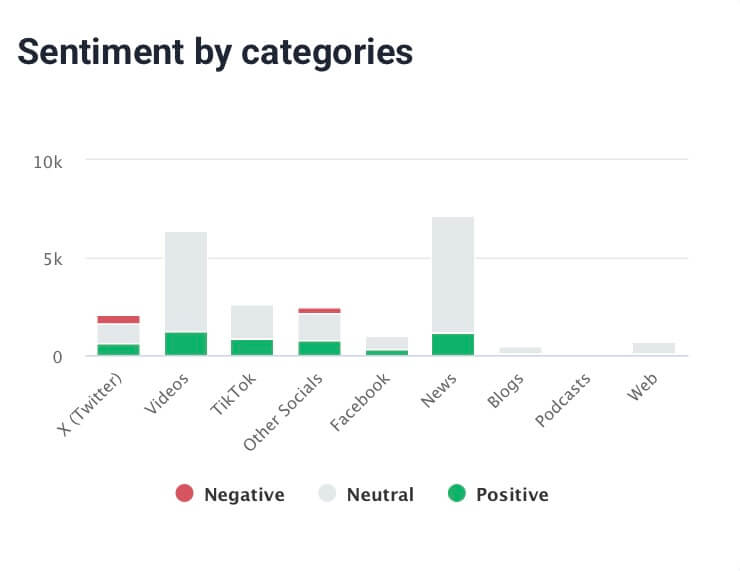
Después de todo, análisis del sentimiento en las redes sociales también puede ayudar a detectar señales tempranas de posibles problemas u oportunidades de crecimiento en el compromiso social.
08 Determine el ROI de sus redes sociales
Sé lo difícil que puede ser medir el ROI de tus actividades en las redes sociales. Especialmente cuando las conversiones no son tu objetivo principal.
Sí, puedes contabilizar las ventas directas o las descargas desde múltiples canales, pero ¿y si tu objetivo es la notoriedad de marca o la influencia en las ventas fuera de línea?
Aun así, el ROI es una parte vital de cualquier auditoría de medios. Te ayuda a asegurarte de que no pierdes tiempo ni presupuesto en canales sociales que no aportan valor real a tu empresa.
Se puede medir el impacto mediante:
- Seguimiento del número de descargas
- Uso de Google Analytics para medir las sesiones orgánicas y las fuentes de tráfico
- Seguimiento del rendimiento de los hashtags para comprobar su visibilidad y el interés de la audiencia
09 Análisis de la competencia
Es hora de evaluar la presencia de su organización en las redes sociales en comparación con otras de su mercado.
Aumentar el rendimiento siempre es emocionante, pero si sus competidores lo están haciendo aún mejor, es una señal de que todavía hay espacio para perfeccionar su contenido en las redes sociales y seguir siendo competitivo.
¿Cómo realizar el análisis competitivo?
Suelo empezar revisando los Ficha Comparación. Esto me permite comparar mis plataformas sociales directamente con las de mis principales competidores, lo que me permite evaluar nuestros rendimiento en línea.
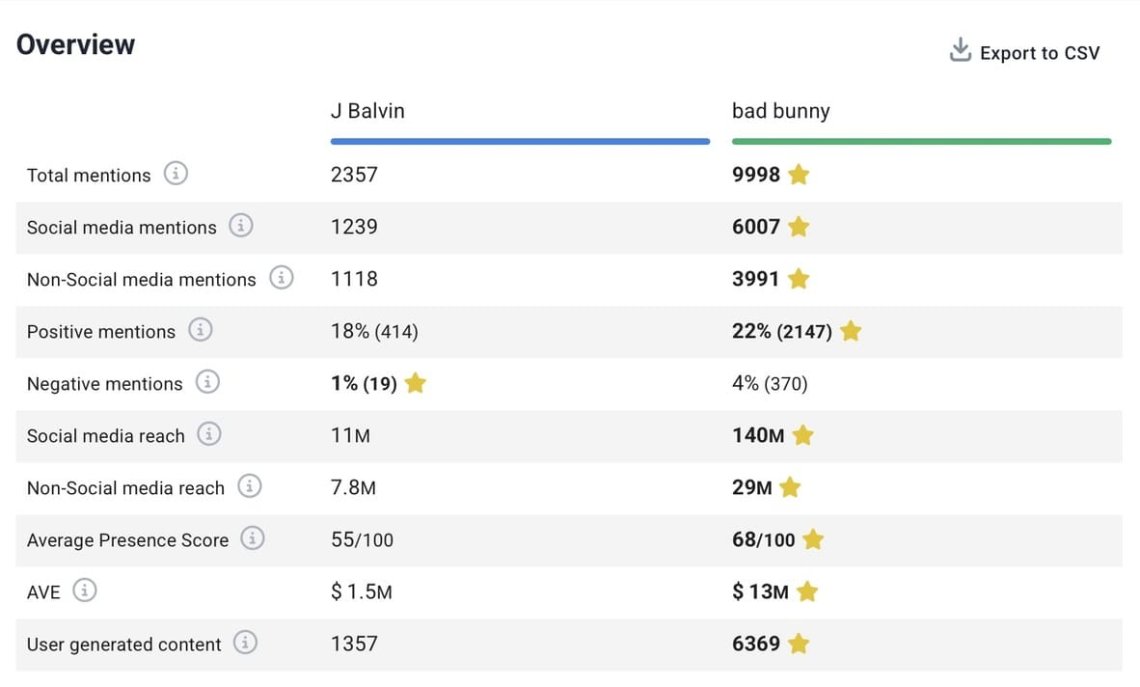
A continuación, compruebo mi puntuación de presencia en línea, que es una instantánea fiable de la solidez de mi visibilidad digital.
Cómo comprobar la fuerza de mi visibilidad online¿S?
Mi consejo es que te fijes en la puntuación de presencia. Mide el grado de notoriedad y actividad de tu marca en los canales sociales y digitales en un momento dado. Esto incluye la interacción, los mention, el alcance y mucho más.
Es especialmente útil para la evaluación comparativa notoriedad de marca y hacer un seguimiento de cómo presencia en los medios sociales está evolucionando.
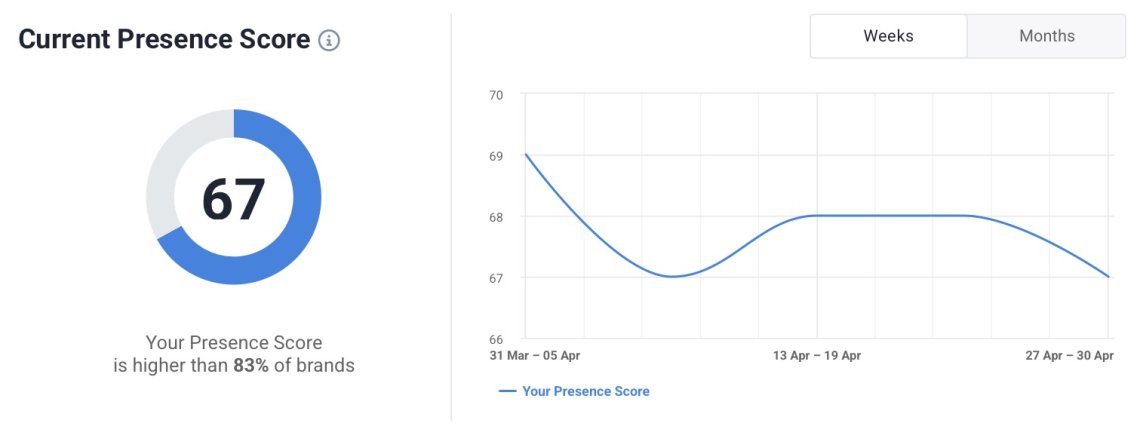
Si la puntuación aumenta, estás avanzando en la dirección correcta. Si no, es hora de profundizar y adaptar tu estrategia de redes sociales.
¿Cuáles son las mejores herramientas de auditoría de redes sociales??
Contar con las herramientas adecuadas para la auditoría de redes sociales es esencial para llevar a cabo una auditoría verdaderamente exhaustiva.
Pero con tantas opciones disponibles, elegir la que mejor se adapte a sus necesidades y objetivos empresariales puede resultar abrumador. Por eso he elaborado una rápida lista de las principales características que debes tener en cuenta:
Qué buscar en una herramienta de auditoría de redes sociales?
- Cobertura de la plataforma
Compruebe qué plataformas sociales admite la herramienta. Asegúrate de que cubre tus cuentas activas en redes sociales y las principales redes sociales en las que la gente puede hablar de tu marca. - Métricas de rendimiento y compromiso
La herramienta debería ayudarte a reunir todos los datos en un solo lugar (desde los datos demográficos de la audiencia hasta el análisis de cada publicación en las redes sociales, pasando por el aumento de seguidores), lo que agilizaría la auditoría de las cuentas en las redes sociales. - Perspectivas y tendencias
Elija una herramienta que le ayude a descubrir información valiosa, incluso la que no resulta evidente a primera vista. - Informes y opciones para compartir
Ahorre tiempo, sobre todo cuando informe a clientes o equipos. Elija una herramienta con cuadros, gráficos y otras visualizaciones fáciles de leer y útiles para la auditoría. - Evaluación comparativa
Muchas herramientas no incorporan funciones de evaluación comparativa. Sin ellas, te verás privado de información sobre audiencias más profundas en el mismo nicho o tendrás que comparar manualmente cuentas o competidores.
Por lo tanto, ¡esas características clave acelerarán su proceso de auditoría! ¿Tiene curiosidad por conocer mis 4 principales herramientas de auditoría de redes sociales ¿Para una auditoría exhaustiva?
¡Vamos a sumergirnos en ellas!
Las 4 mejores herramientas de auditoría de redes sociales:
01. Google Analytics
Claro, técnicamente es más una herramienta de análisis de sitios web, pero es indispensable para comprender cómo la actividad en las redes sociales afecta el tráfico de tus redes sociales, el comportamiento de los usuarios y los objetivos de conversión.
Google Analytics es una plataforma fundamental en cualquier auditoría de redes sociales, ya que ofrece información valiosa que acorta la distancia entre la participación social y el rendimiento del sitio web.
Revela cómo se comportan los usuarios de diversos canales sociales una vez que llegan a tu sitio web, lo que lo convierte en una herramienta fundamental para optimizar tu estrategia de marketing en redes sociales.

¿Cómo utilizar GA para la auditoría de redes sociales?
- Análisis de fuentes de tráfico: Descubre qué cuentas de redes sociales generan más tráfico.
- Datos demográficos de la audiencia: Obtenga datos demográficos detallados sobre edad, sexo, ubicación e intereses.
- Seguimiento de las conversiones: Comprenda cómo contribuyen los esfuerzos sociales a sus objetivos.
- Informes personalizados: Cree cuadros de mando personalizados para el seguimiento de objetivos de marketing y KPI específicos.
Consejo profesional: Combina Google Analytics con parámetros UTM para obtener una visión más profunda del rendimiento de publicaciones, campañas o plataformas emergentes específicas.
Aunque no analiza el contenido de las redes sociales, Google Analytics es una herramienta imprescindible para el análisis de los sitios web con el fin de comprender cómo se traducen los esfuerzos de las redes sociales en valor empresarial.
02. Brand24
Hoy en día, no basta con hacer un seguimiento del rendimiento de los contenidos. Una auditoría de redes sociales realmente eficaz requiere una visión completa de cómo se percibe su marca en la web.
¿Qué dice la gente de usted? ¿Sus campañas generan un eco positivo o se quedan cortas?
Brand24 es una herramienta de escucha social basada en inteligencia artificial que ayuda a responder esas preguntas cruciales.
Supervisa las conversaciones en todas las principales plataformas de redes sociales (incluidos blogs, foros, podcasts y sitios de reseñas). De este modo, podrás estar completamente informado sobre la presencia y la reputación online de tu marca.
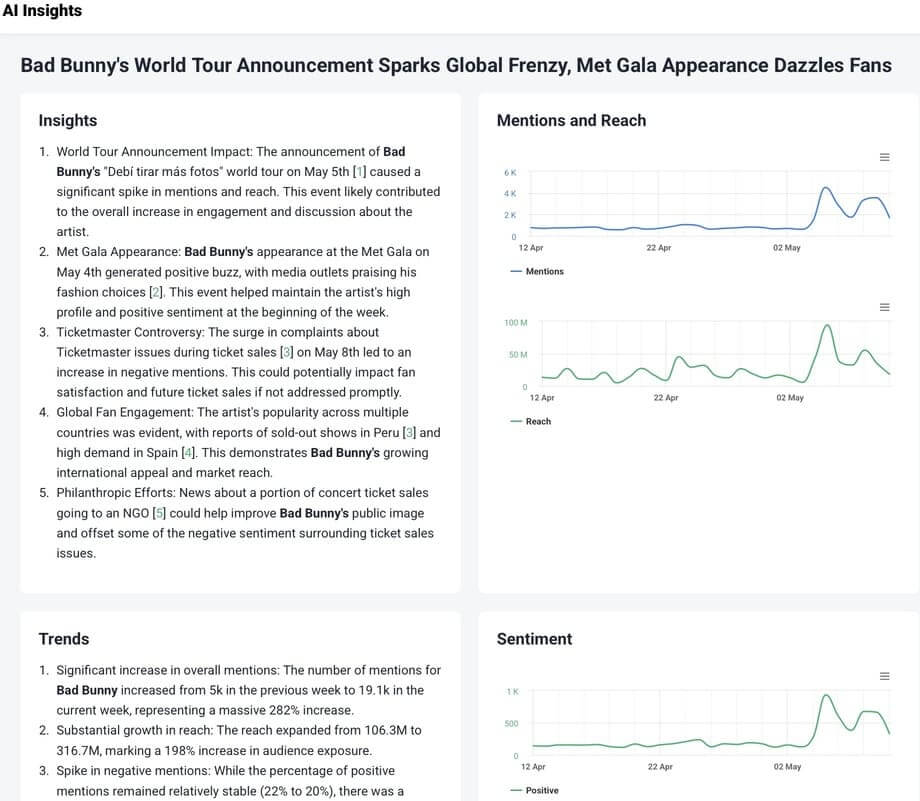
¿Cómo utilizar Brand24 para la auditoría de redes sociales?
- Utilice informes automatizados: Exporta informes limpios en PDF, Excel, infografías o utiliza Quick Share Reports para enviar actualizaciones a cualquier persona: clientes, compañeros de equipo o partes interesadas. Me ahorra horas cada semana.
- Características de la IA: Obtenga análisis instantáneos del sentimiento, temas de tendencia, reacciones de la audiencia y recomendaciones detalladas con AI Brand Assistant.
- Descubrimiento de contenido y seguimiento de influencers: Identifica las publicaciones e interacciones sociales de alto impacto. Gracias al análisis de influencers, puedes encontrar a los creadores que impulsan las conversaciones en un nicho de forma más natural.
- Evaluación comparativa: No se limite a los nombres de marca, supervise cualquier eslogan, hashtag, nombre de producto o campaña para ver también cómo están actuando los competidores.
- Demografía: Acceda a información sobre su público, como edad, sexo y perfil.
Explora casos prácticos e inspiración en nuestra guía para ejemplos de escucha social y descubra cómo los profesionales del marketing, las agencias y las empresas utilizan Brand24 para crear comunidades fieles y basadas en datos.
03. BuzzSumo
BuzzSumo es una herramienta para análisis de redes sociales. Diseñado para realizar un seguimiento de las marcas mention y las tendencias en línea, en lugar de realizar un seguimiento del rendimiento de la marca en todas sus cuentas.
Identifica compromiso de la comunidad de contenidos, detecta temas emergentes e identifica voces influyentes en el sector. Es una de las herramientas más sencillas para identificar lo que funciona y por qué.
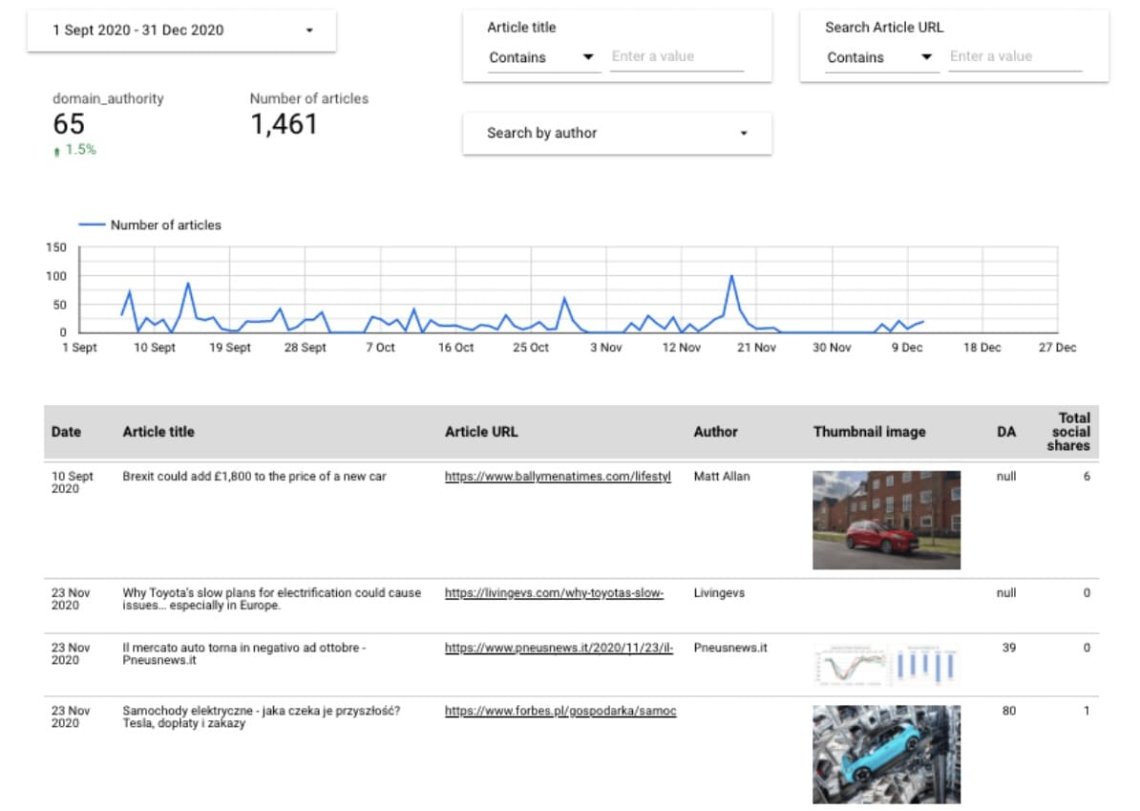
¿Cómo utilizar BuzzSumo para auditar las redes sociales?
- Auditoría de contenidos: Analice los contenidos de mayor rendimiento en plataformas, competidores o temas específicos.
- Influencer Insights: Identifica a las personas clave que amplifican tus contenidos o los de tus competidores.
- Detección de tendencias: Configura alertas para palabras clave emergentes y recibe notificaciones cuando algo se vuelva viral.
- Investigación de temas: Descubrir lagunas en los contenidos y explorar oportunidades estratégicas para orientar los contenidos futuros.
04. Tampón
Tampón facilita la gestión diaria de las redes sociales. Especialmente para equipos pequeños o profesionales del marketing en solitario.
Aunque no está pensada para obtener información y análisis en profundidad ni para hacer un seguimiento de las tendencias, su programación intuitiva y su interfaz limpia la convierten en una de las favoritas para mantenerse organizado y coherente.
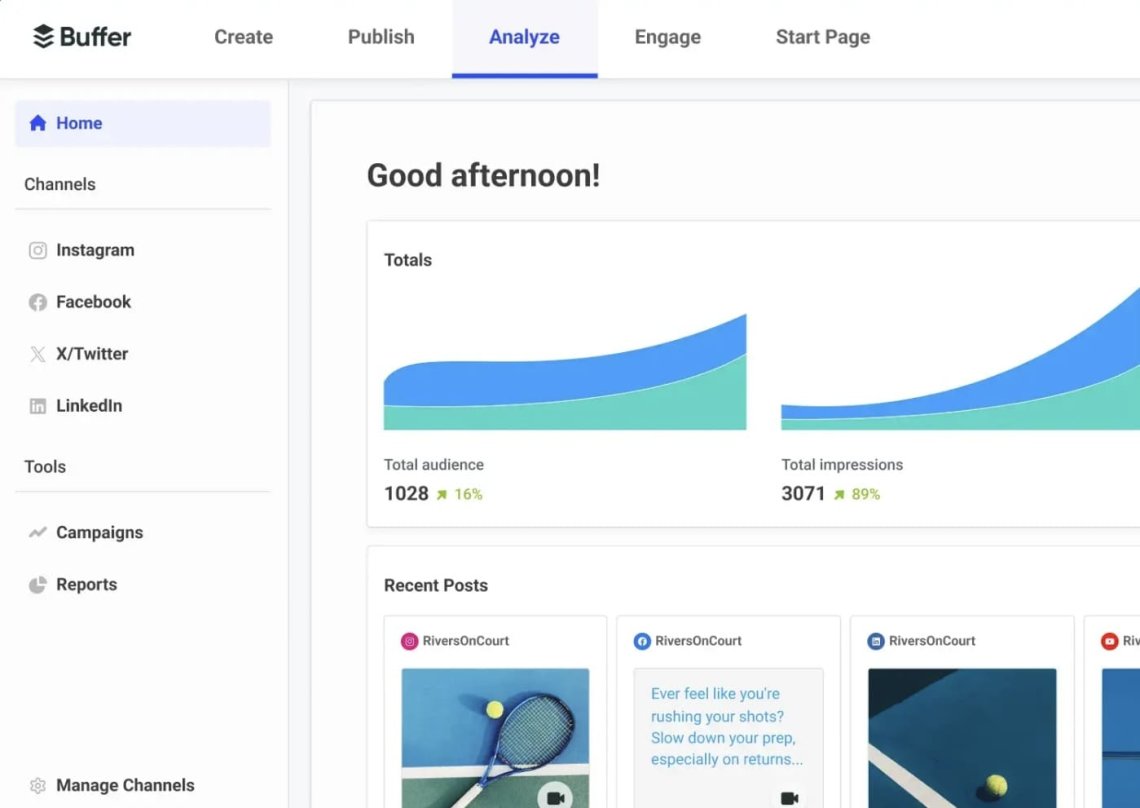
¿Cómo utilizar Buffer para auditar las redes sociales?
- Análisis de publicaciones e historias: Realiza un seguimiento del número de seguidores, los "me gusta", los clics y la participación en cada una de las publicaciones de las redes sociales.
- Rendimiento de la cuenta: Medición de métricas en múltiples plataformas.
- Datos demográficos de la audiencia: Entienda a quién está llegando y adapte el contenido en consecuencia.
Utiliza Buffer para programar publicaciones de forma coherente y, a continuación, combina sus datos con Google Analytics o Brand24 para obtener una visión más amplia del rendimiento y el impacto.
Cómo analizar los resultados de una auditoría de redes sociales?
- No ignores el contexto: Los datos recopilados son esenciales, pero detrás de ellos están las personas. Comprender las preferencias de la audiencia, el momento oportuno y la relevancia de los contenidos es tu arma secreta.
- Sé coherente: Realice auditorías periódicas de las redes sociales para asegurarse de que su estrategia se basa en datos pertinentes.
- Se trata de las personas: Al final del día, estás construyendo una red social. Dé prioridad a la participación auténtica, mantenga fresco su contenido en las redes sociales y explore nuevas plataformas en las que pueda estar su público.
- Personaliza las plantillas: Las plantillas de auditoría de redes sociales son un buen punto de partida. Pero no tengas miedo de modificarlas.
- Aproveche una herramienta de IA: como Asistente de marcapara obtener información más rápidamente, detectar patrones y ahorrar tiempo en varios canales de redes sociales.
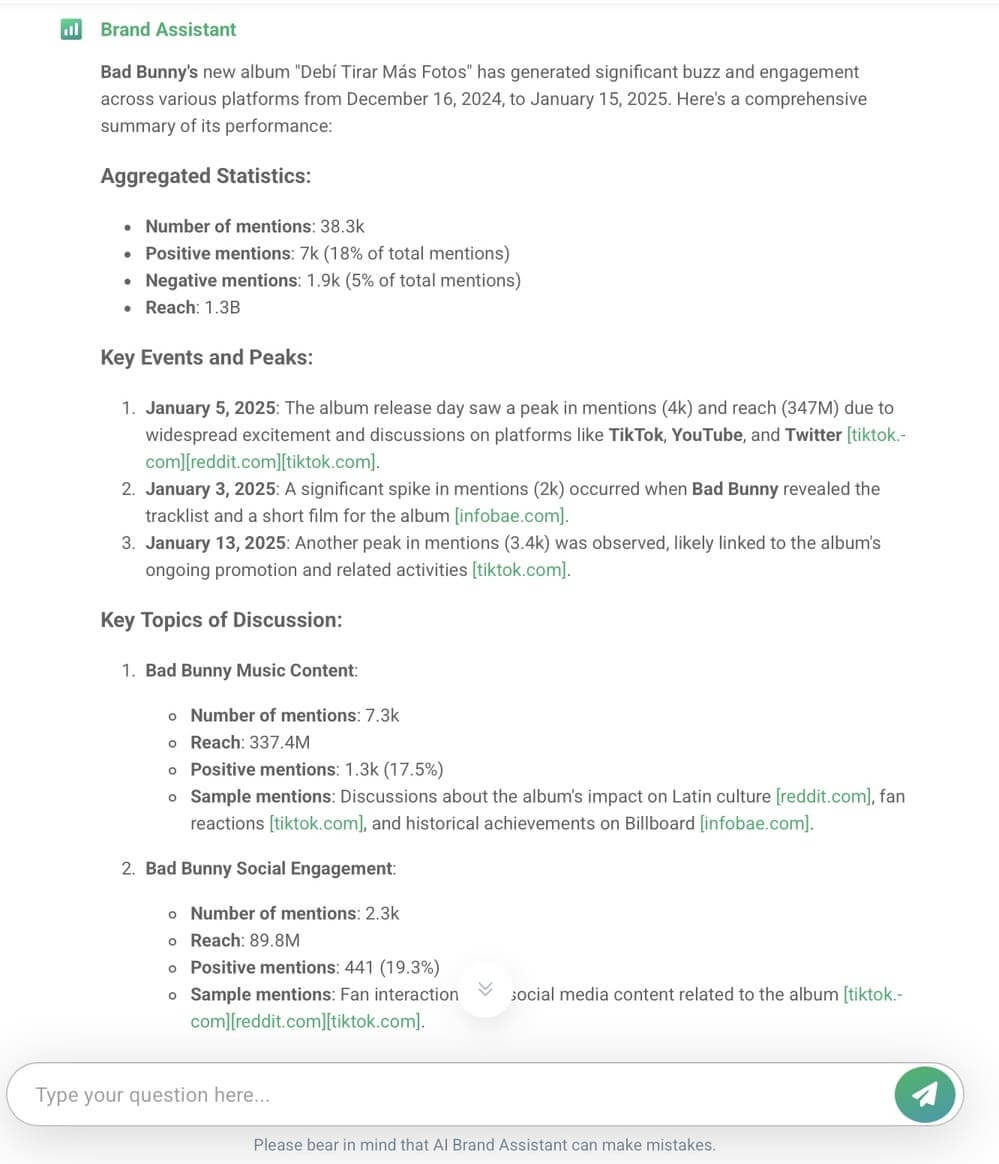
Plantilla y lista de comprobación para la auditoría de redes sociales
Una plantilla de auditoría de redes sociales te ayuda a revisar todos tus perfiles, evaluar el rendimiento e identificar áreas de mejora.
Te guía a través del análisis de cuentas, la comprobación de la coherencia de la marca, la revisión de métricas clave, la comprensión de tu público, el estudio de la competencia y la creación de un plan de acción claro para reforzar tu estrategia en redes sociales.
Aquí puede utilizar esta lista de comprobación de auditoría de medios sociales lista para usar que he preparado para usted:
| Sección de auditoría | ¿Qué hacer? cmaldición? |
|---|---|
| Lista de cuentas | Reúna todos los perfiles activos e inactivos y confirme que se ajustan a su público objetivo. |
| Coherencia de la marca | Asegúrate de que las fotos de perfil, las imágenes de portada, los nombres de usuario, las URL, las biografías y la verificación estén unificados y actualizados. |
| Métricas clave | Realiza un seguimiento del compromiso (me gusta, comentarios, comparticiones), la visibilidad (alcance, impresiones, clics) y el contenido con mejor rendimiento. |
| Comprenda a su público | Analizar datos demográficos, comportamiento, opiniones y patrones de interacción en todas las plataformas. |
| Análisis de la competencia | Revisa el contenido, el rendimiento y la participación de la competencia para identificar oportunidades. |
| Crear un plan de acción | Utiliza los resultados de la auditoría para establecer objetivos y definir medidas que mejoren tu estrategia en redes sociales. |
PREGUNTAS FRECUENTES
P1: ¿Qué es una auditoría de redes sociales?
Una auditoría de redes sociales es una revisión estructurada de toda la presencia de tu marca en las redes sociales. Examina tus perfiles, el rendimiento del contenido, el comportamiento de la audiencia, los mention de la marca, la opinión y el panorama de la competencia para identificar qué funciona, qué hay que mejorar y dónde existen oportunidades.
P2: ¿Por qué es importante una auditoría de redes sociales?
Una auditoría de redes sociales te ayuda a:
- Comprenda su verdadero rendimiento social
- Descubra sus fortalezas, debilidades y oportunidades de crecimiento.
- Detecta marcas obsoletas o canales inactivos.
- Mejora las estrategias de contenido basadas en datos reales.
- Alinea tu actividad social con los objetivos empresariales.
- Supervisar la reputación y la opinión sobre la marca.
- Optimizar la asignación de recursos y las decisiones presupuestarias.
P3: ¿Qué es una plantilla de auditoría de redes sociales?
Una plantilla de auditoría de redes sociales es una hoja de cálculo o una hoja de trabajo estructurada diseñada para guiarte paso a paso en la evaluación de tu presencia en las redes sociales. Te garantiza que recopiles toda la información necesaria y sigas un proceso coherente en cada ocasión.
Una plantilla sólida incluye:
- Métricas de rendimiento (alcance, interacción, clics, opinión)
- Análisis del contenido
- Métricas de la competencia
- Recomendaciones y próximos pasos
P4: ¿Por qué utilizar una plantilla de auditoría de redes sociales?
El uso de una plantilla ayuda porque:
- Garantiza cobertura completa de todos los canales sociales
- Trae consistencia, especialmente para auditorías recurrentes
- Organiza datos para facilita la presentación de informes y la comparación
- Ahorra tiempo al proporcionarte un marco claro.
P5: ¿Con qué frecuencia debo realizar una auditoría de redes sociales?
La mayoría de las marcas realizan auditorías. trimestral, mientras que las empresas de rápido crecimiento o aquellas que llevan a cabo campañas intensivas pueden hacerlo. mensualmente. También es útil realizar una auditoría completa:
- Después del cambio de marca
- Antes de planificar una nueva estrategia social
- Después de actualizaciones importantes de la plataforma
- Cuando el rendimiento cae repentinamente o aumenta el sentimiento negativo
P6: ¿Necesito alguna herramienta especial para realizar una auditoría de redes sociales?
Puede realizar una auditoría básica manualmente, pero herramientas de automatización de redes sociales Aumenta significativamente la precisión y reduce el tiempo. Las herramientas también pueden ayudarte a crear informes automatizados.



